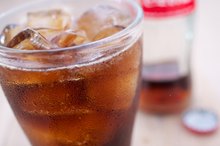What does fact checked mean?
At Healthfully, we strive to deliver objective content that is accurate and up-to-date. Our team periodically reviews articles in order to ensure content quality. The sources cited below consist of evidence from peer-reviewed journals, prominent medical organizations, academic associations, and government data.
- PubChem: Malic Acid
- Journal of Endourology: Malic Acid Supplementation Increases Urinary Citrate Excretion and Urinary pH: Implications for the Potential Treatment of Calcium Oxalate Stone Disease
- Journal of Endourology: Malic Acid Supplementation Increases Urinary Citrate Excretion and Urinary pH: Implications for the Potential Treatment of Calcium Oxalate Stone Disease
- MedlinePlus: Magnesium
- Oregon State University: Linus Pauling Institute: Niacin
- MedlinePlus: Tryptophan
The information contained on this site is for informational purposes only, and should not be used as a substitute for the advice of a professional health care provider. Please check with the appropriate physician regarding health questions and concerns. Although we strive to deliver accurate and up-to-date information, no guarantee to that effect is made.
Acids Found in Apple Juice
Apple juice doesn’t taste very acidic, but it does retain the raw apple’s acids. These acids are active in your body, where they help produce energy and support metabolism. As long as your apple juice is 100-percent unsweetened juice, it contributes to your daily fruit intake. But don’t drink too much juice because it doesn’t contain the fiber you’ll get from raw apples, and prolonged exposure to the acids can erode tooth enamel.
Apple Juice Acidity
Apple juice has about the same level of acidity as orange juice, but it doesn’t have the same acidic bite because the two have different acid profiles. The primary acid in orange juice is citric acid, while apple juice is high in malic acid, which tastes less bitter than citric acid 3.
Even though apple juice contains about six acids, only a few are present in significant amounts, according to a 2005 report in the Journal of Food Composition and Analysis 2. After malic acid, the next most predominant acids are quinic and chlorogenic acids, followed by a small amount of citric acid 3.
Malic Acid Boosts Energy
Acid in Lemon Juice
Learn More
When cells in your body produce energy, they follow a step-wise chain of reactions. Each step requires the interaction of specific compounds before the next step can begin. All steps must be completed in order to synthesize energy. Malic acid is needed to complete one of the steps 3. Because malic acid has such an essential job, your body makes its own rather than relying on dietary sources 3.
Malic acid shows promise for treating calcium kidney stones, reported the Journal of Endourology in February 2014 34. It’s also used together with magnesium to help reduce pain caused by fibromyalgia and to relieve the exhaustion of chronic fatigue syndrome 5. More research is needed to verify malic acid’s ability to improve all of these health conditions, however 3.
- When cells in your body produce energy, they follow a step-wise chain of reactions.
- Malic acid is needed to complete one of the steps 3.
Quinic Acid Supports Metabolism
Quinic acid is the second most abundant acid in apple juice. When healthy volunteers took quinic acid, researchers at Lund University in Sweden found that levels of nicotinamide and tryptophan also increased, according to an article in Phytotherapy Research in March 2009 7.
Nicotinamide is the form of niacin the body uses to make enzymes that metabolize carbs, fats and protein. The amino acid tryptophan is converted into serotonin, which helps regulate mood and sleep cycles 7.
- Quinic acid is the second most abundant acid in apple juice.
- When healthy volunteers took quinic acid, researchers at Lund University in Sweden found that levels of nicotinamide and tryptophan also increased, according to an article in Phytotherapy Research in March 2009 7.
Chlorogenic Acid for Diverse Benefits
Side Effects of Drinking Water With High Haloacetic Acids
Learn More
Your cup of apple juice also contains chlorogenic acid, which is an antioxidant naturally produced by plants. Chlorogenic acid is the subject of ongoing studies because it's one of the primary acids found in coffee.
When chlorogenic acid was given to laboratory mice, they lost weight and their levels of triglycerides went down, according to a report in Food and Chemical Toxicology in March 2010. Chlorogenic acid also shows promise for lowering the risk of diabetes by preventing peaks in blood sugar, according to studies cited in Evidence-Based Complementary and Alternative Medicine in August 2013.
- Your cup of apple juice also contains chlorogenic acid, which is an antioxidant naturally produced by plants.
- When chlorogenic acid was given to laboratory mice, they lost weight and their levels of triglycerides went down, according to a report in Food and Chemical Toxicology in March 2010.
Related Articles
References
- Delta Dental: Acid Attack
- Journal of Food Composition and Analysis: The Partial Compositional Characteristics of Apple Juice From 174 Varieties
- PubChem: Malic Acid
- Journal of Endourology: Malic Acid Supplementation Increases Urinary Citrate Excretion and Urinary pH: Implications for the Potential Treatment of Calcium Oxalate Stone Disease
- University of Maryland Medical Center: Chronic Fatigue Syndrome
- Oregon State University: Linus Pauling Institute: Niacin
- MedlinePlus: Tryptophan
- Taylor MB, Yanaki JS, Draper DO, Shurtz JC, Coglianese M. Successful short-term and long-term treatment of melasma and postinflammatory hyperpigmentation using vitamin C with a full-face iontophoresis mask and a mandelic/malic acid skin care regimen. J Drugs Dermatol. 2013 Jan;12(1):45-50.
- Tyka AK, Chwastowski M, Cison T, et al. Effect of creatine malate supplementation on physical performance, body composition and selected hormone levels in spinters and long-distance runners. Acta Physiol Hung. 2015 Mar;102(1):114-22. doi:10.1556/APhysiol.102.2015.1.12
- Rodgers AL, Webber D, de Charmoy R, Jackson GE, Ravenscroft N. Malic acid supplementation increases urinary citrate excretion and urinary pH: implications for the potential treatment of calcium oxalate stone disease. J Endourol. 2014 Feb;28(2):229-36. doi:10.1089/end.2013.0477
- Manfredini R, De giorgi A, Storari A, Fabbian F. Pears and renal stones: possible weapon for prevention? A comprehensive narrative review. Eur Rev Med Pharmacol Sci. 2016;20(3):414-25.
- Russell IJ, Michalek JE, Flechas JD, Abraham GE. Treatment of fibromyalgia syndrome with Super Malic: a randomized, double blind, placebo controlled, crossover pilot study. J Rheumatol. 1995;22(5):953-8.
- Gómez-Moreno G, Aguilar-Salvatierra A, Guardia J, et al. The efficacy of a topical sialogogue spray containing 1% malic acid in patients with antidepressant-induced dry mouth: a double-blind, randomized clinical trial. Depress Anxiety. 2013 Feb;30(2):137-42. doi:10.1002/da.22017
- Tang SC, Yang JH. Dual Effects of Alpha-Hydroxy Acids on the Skin. Molecules. 2018;23(4). doi:10.3390/molecules23040863
Resources
Writer Bio
Sandi Busch received a Bachelor of Arts in psychology, then pursued training in nursing and nutrition. She taught families to plan and prepare special diets, worked as a therapeutic support specialist, and now writes about her favorite topics – nutrition, food, families and parenting – for hospitals and trade magazines.









